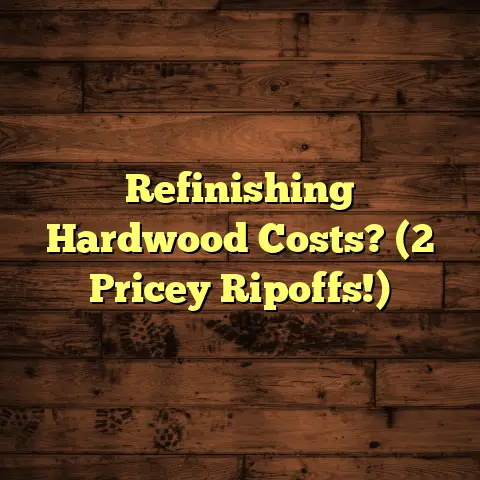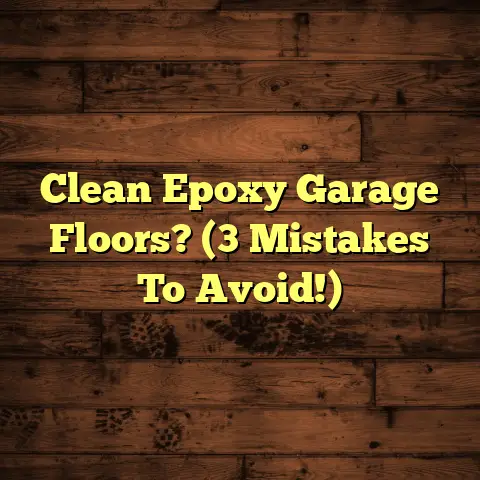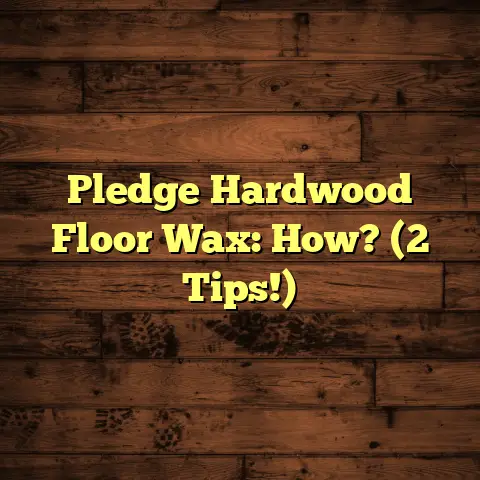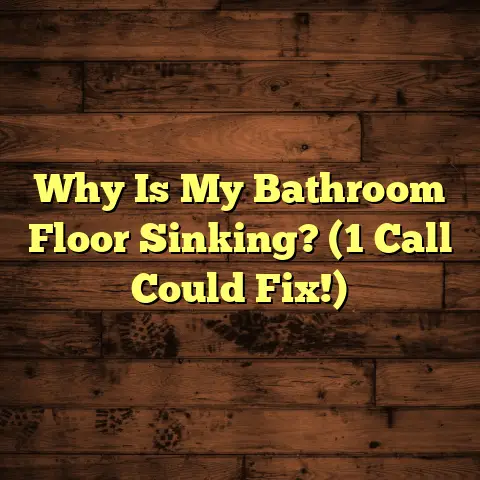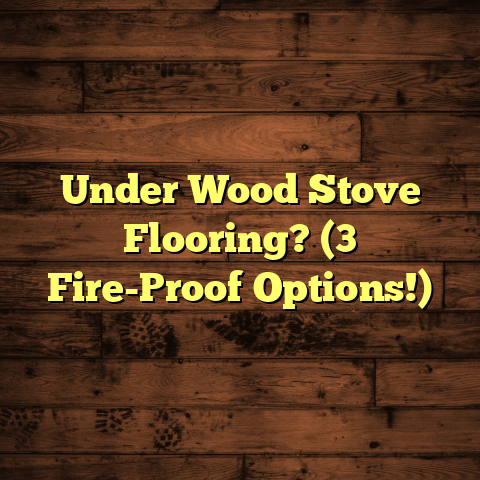Vinyl Plank Problems? (1 Fix You Must Know!)
Let’s talk about vinyl plank flooring.
It’s affordable, durable, and looks great.
But let’s be real, it’s not always sunshine and rainbows.
I’ve seen it all in my years as a flooring contractor: warping, buckling, scratches, peeling… you name it.
You’re not alone if you’re dealing with these issues.
According to a recent survey by the National Association of Home Builders, vinyl flooring is installed in over 20% of new homes.
That’s a lot of potential problems!
But don’t worry, there’s usually a fix.
And I’m going to share one essential solution that can bring your floors back to life.
Ready to dive in?
Section 1: Understanding Vinyl Plank Flooring
So, what exactly is vinyl plank flooring?
It’s a synthetic flooring option made from multiple layers of PVC and other materials.
It’s designed to mimic the look of hardwood or tile, but it’s much more water-resistant and budget-friendly.
Think of it as the chameleon of the flooring world.
It can adapt to almost any style.
Unlike hardwood, which is solid wood, or laminate, which is a composite material with a photographic layer, vinyl plank is completely synthetic.
This makes it more resistant to moisture and scratches than laminate, but not as durable as solid hardwood.
Installation:
Vinyl plank flooring is typically installed as either a “click-lock” floating floor or glued down directly to the subfloor.
Click-lock is popular for DIYers, while glue-down is often preferred for commercial spaces or areas with high moisture.
I’ve seen vinyl plank used everywhere.
From basements and bathrooms to kitchens and living rooms.
It’s a versatile option that can handle a lot of abuse.
Pros and Cons:
Why do homeowners choose vinyl plank?
- Affordability: It’s cheaper than hardwood or tile.
- Durability: It can withstand heavy foot traffic and spills.
- Water Resistance: Great for moisture-prone areas.
- Easy Installation: Especially the click-lock type.
- Aesthetic Appeal: It looks good!
But, like everything, it has its downsides:
- Not as Durable as Hardwood: It can scratch and dent.
- Can be Affected by Extreme Temperatures: Leading to expansion and contraction.
- Not Always Eco-Friendly: Some vinyl planks contain harmful chemicals.
- Can Look Less Luxurious: Compared to real wood or stone.
Despite these potential problems, the benefits often outweigh the risks for many homeowners.
The key is to choose a high-quality product and install it correctly.
Section 2: Common Problems with Vinyl Plank Flooring
Alright, let’s get to the nitty-gritty.
What are the most common issues I see with vinyl plank flooring?
Warping and Buckling:
This is a big one.
Warping and buckling happen when the planks expand and contract due to moisture or temperature changes.
Imagine a hot summer day… your vinyl planks start to swell.
Then, in the winter, they shrink.
Over time, this can cause them to lift and buckle.
- Causes:
- Moisture Exposure: Leaks, spills, or high humidity.
- Improper Installation: Not leaving enough expansion space around the edges of the room.
- Subfloor Issues: An uneven or unstable subfloor.
I once had a client whose vinyl plank floor buckled because their washing machine leaked for weeks without them knowing.
The moisture seeped under the planks and caused them to warp like crazy.
Scratches and Scuffs:
No matter how careful you are, scratches and scuffs are inevitable.
Furniture, pets, and even just walking on the floor can leave marks.
- Causes:
- Everyday Wear and Tear: Foot traffic, moving furniture.
- Pets: Claws can scratch the surface.
- Sharp Objects: Dropping knives or dragging heavy items.
I always recommend using furniture pads under tables and chairs to minimize scratches.
Peeling and Lifting:
This usually happens with glue-down vinyl plank flooring.
The adhesive starts to fail, and the planks begin to lift from the subfloor.
- Causes:
- Adhesive Failure: Using the wrong type of adhesive or not applying it properly.
- Subfloor Issues: A dirty or uneven subfloor can prevent the adhesive from bonding correctly.
- Moisture: Moisture can weaken the adhesive.
I’ve seen cases where the installer didn’t properly prepare the subfloor, and the planks started peeling within months.
Discoloration and Fading:
Over time, sunlight and certain cleaning products can cause vinyl plank flooring to fade or discolor.
- Causes:
- Sunlight: UV rays can break down the pigments in the vinyl.
- Harsh Cleaning Products: Some chemicals can damage the surface.
I advise clients to use curtains or blinds to block direct sunlight and to use pH-neutral cleaning products.
Real-Life Examples:
- Case Study 1: A homeowner installed vinyl plank in their basement. They didn’t install a proper vapor barrier, and the planks started warping due to moisture from the concrete slab.
- Case Study 2: A family with two large dogs installed vinyl plank in their living room. Within a year, the floor was covered in scratches from the dogs’ claws.
- Case Study 3: A restaurant installed glue-down vinyl plank in their kitchen. The floor started peeling because the subfloor wasn’t properly cleaned and prepped.
(Visuals: Here, I’d include photos of warped, scratched, peeling, and discolored vinyl plank flooring to illustrate the problems.)
Section 3: The Fix You Must Know
Okay, now for the good stuff.
What’s the one essential fix that can address many of these vinyl plank problems?
The answer: Replacing Damaged Planks!
I know it sounds simple, but trust me, it’s the most effective way to restore your flooring.
Whether you’re dealing with warping, scratches, peeling, or discoloration, replacing the affected planks can make a huge difference.
Why this works:
- Addresses the Root Cause: It removes the damaged material.
- Restores Appearance: It brings back the original look of the floor.
- Prevents Further Damage: It stops the problem from spreading.
Step-by-Step Guide to Replacing Vinyl Planks:
Here’s how to do it, step-by-step:
Step 1: Gather Your Tools and Materials
You’ll need:
- Replacement Planks: Make sure they’re the exact same type and color as your existing flooring. (Always buy extra when you initially install!)
- Utility Knife: For scoring and cutting the planks.
- Straight Edge: A metal ruler or level will work.
- Hammer: For tapping the planks into place.
- Tapping Block: To protect the planks from damage when hammering.
- Pry Bar: To gently lift the damaged planks.
- Gloves and Safety Glasses: Safety first!
- (For Glue-Down): Heat Gun or Hair Dryer, Putty Knife, Adhesive Remover, New Adhesive.
Step 2: Prepare the Area
Clear the area around the damaged planks.
Remove any furniture or obstacles.
Step 3: Remove the Damaged Plank(s) (Click-Lock)
- Locate the Seams: Find the seams of the damaged plank.
- Score the Plank: Use the utility knife and straight edge to score along the seams.
- Pry it Up: Use the pry bar to gently lift the plank. Start at a corner and work your way around.
- Be Careful: Avoid damaging the surrounding planks.
Step 3: Remove the Damaged Plank(s) (Glue-Down)
- Heat the Plank: Use a heat gun or hair dryer to warm the adhesive. This will make it easier to remove.
- Score the Plank: Use the utility knife and straight edge to score along the seams.
- Pry it Up: Use the putty knife to gently lift the plank. Work slowly and carefully.
- Remove Adhesive: Use adhesive remover to clean any remaining adhesive from the subfloor.
Step 4: Prepare the Replacement Plank
- Measure and Cut: Measure the replacement plank to ensure it fits perfectly. Use the utility knife and straight edge to cut it to size.
- (For Click-Lock): Make sure the edges are clean and free of debris.
- (For Glue-Down): Apply a thin, even layer of new adhesive to the back of the plank.
Step 5: Install the Replacement Plank (Click-Lock)
- Angle and Insert: Angle the replacement plank and insert it into the seams of the surrounding planks.
- Tap it into Place: Use the tapping block and hammer to gently tap the plank into place.
- Listen for the Click: You should hear a click when the plank is properly locked in.
Step 5: Install the Replacement Plank (Glue-Down)
- Position Carefully: Carefully position the replacement plank over the open area.
- Press Firmly: Press down firmly to ensure the adhesive bonds to the subfloor.
- Clean Excess Adhesive: Wipe away any excess adhesive with a damp cloth.
- Weight it Down: Place a heavy object (like a book or brick) on top of the plank for several hours to allow the adhesive to cure.
Step 6: Clean Up
- Remove Debris: Clean up any debris or leftover adhesive.
- Inspect Your Work: Make sure the replacement plank is flush with the surrounding planks.
Troubleshooting Tips:
- Plank Won’t Come Up: Apply more heat (for glue-down) or try a different angle with the pry bar (for click-lock).
- New Plank Doesn’t Fit: Double-check your measurements and make sure you’re using the correct type of plank.
- Adhesive Won’t Stick: Make sure the subfloor is clean and dry. Use a high-quality adhesive.
Real-Life Application:
I had a client named Sarah who had a large scratch on her vinyl plank floor in the living room.
Her dog had dragged a metal toy across the floor, leaving a deep, unsightly mark.
Sarah was devastated.
She thought she would have to replace the entire floor.
I told her, “Don’t worry, Sarah, we can fix this!”
We followed the steps above, carefully removing the damaged plank and replacing it with a new one.
It took about an hour, but the results were amazing.
Sarah was thrilled.
She said, “I can’t even tell there was ever a scratch there! You saved me so much money!”
(Before and After Photos: Here, I’d include before-and-after photos of a vinyl plank floor with a replaced plank to show the dramatic improvement.)
Variations of the Fix:
- For Minor Scratches: You can sometimes buff out minor scratches with a scratch repair kit. These kits usually contain a special compound that fills in the scratches and restores the surface.
- For Small Dents: You can try using a heat gun to gently warm the dent and then press it back into shape.
- For Peeling Edges: You can use a small amount of adhesive to re-glue the edges back down.
Section 4: Maintenance Tips Post-Fix
Alright, you’ve successfully replaced your damaged planks.
Now, how do you prevent future problems?
Here are some essential maintenance tips:
- Regular Cleaning: Sweep or vacuum your vinyl plank floor regularly to remove dirt and debris. Use a damp mop with a pH-neutral cleaner to clean the floor. Avoid using harsh chemicals or abrasive cleaners.
- Proper Humidity Control: Maintain a consistent humidity level in your home to prevent warping and buckling. Use a dehumidifier in humid climates and a humidifier in dry climates.
- Protective Measures: Use furniture pads under tables and chairs to prevent scratches. Place mats at entrances to trap dirt and debris. Avoid wearing shoes with sharp heels on the floor.
- Routine Inspections: Inspect your floor regularly for any signs of damage. Look for scratches, dents, peeling edges, or warping. Address any problems early before they escalate.
- Avoid Direct Sunlight: Use curtains or blinds to block direct sunlight, which can cause fading and discoloration.
- Use the Right Cleaning Products: Avoid using abrasive cleaners, bleach, or ammonia-based products. These can damage the surface of the vinyl plank.
- Don’t Drag Heavy Objects: When moving furniture, lift it instead of dragging it across the floor. If you must drag it, use furniture sliders to protect the floor.
Conclusion
So, there you have it.
Vinyl plank flooring can be a great option for your home, but it’s not without its potential problems.
Warping, scratching, peeling, and discoloration are all common issues that homeowners face.
But the good news is that these problems are often fixable.
By replacing the damaged planks, you can restore your flooring to its former glory and prevent further damage.
Remember to follow the step-by-step guide I’ve provided and to take preventative measures to protect your floor from future problems.
Don’t be afraid to tackle these issues yourself.
With a little bit of knowledge and effort, you can keep your vinyl plank floor looking beautiful for years to come.
Now go forth and conquer those flooring foes!
